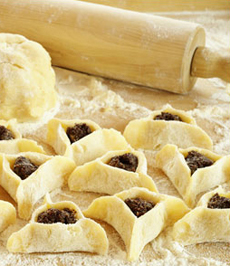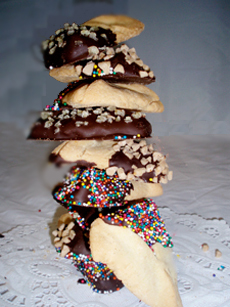
 You don’t have to be Jewish to whip up a batch of hamantaschen. Photo courtesy Zabars.com.
February 2010
|
 |
Hamantaschen Recipe
Spell It Hamantashen, Hamentaschen Or Any Other Way: These Purim Cookies Are Delicious Year-Round
Purim Overview
Hamantashen are delicious year-round, so why do we only think about them for Purim (the beginning of March)? Once you make this recipe, you’ll want them more often.
The story of the Jewish holiday of Purim, as told in the Bible’s Book of Esther, tells of the deliverance of the Jewish people from an annihilation plot of the Persian king Haman. This book is called “The Megillah” in Hebrew, leading to the expression “the whole megillah” or the whole story.
During the annual Purim storytelling—the reading of The Megillah—participants drown out the name of the villain Haman each time it is read, by using a “grogger,” the Yiddish word for noisemaker.
The name Purim means “lots,” which, like rolling dice, were used to determine when the Jews would be destroyed. The Jews’ fate was reversed, thanks to the leadership of the heroic Queen Esther; and a day of planned destruction turned into a day of joyous redemption. Purim is celebrated on the 14th or 15th day of Adar in the Hebrew calendar (around March 1st).
Hamantaschen Cookies
Like most Jewish holidays, this one has its traditional food, hamantashen (singular, hamantasch, and also spelled hamentashen, hamantashen, homentash, homentasch and humentash), which means “Haman’s pockets” in Yiddish. Hamantashen is a triangular-shaped pastry with a cookie-like dough (a cross between a cookie and a tart), not particularly sweet, originally filled with a sweetened poppy seed (“mon”) or prune paste. The triangle shape references the three-cornered hat worn by Haman.
Today hamantashen is made with a variety of fillings to please modern palates: apricot, prune and raspberry as well as poppy Around Purim, they appear in bakeries, and can be purchased online at The Exceptional Dessert. They’re a lovely little pastry to enjoy with coffee or tea.
Hamantaschen Recipe
Ingredients
Cookies
- 2 ½ cups all purpose flour
- Extra flour for rolling out dough
- ½ cup sugar
- ¾ pound unsalted butter, cold
- 1 teaspoon grated lemon rind
- ½ teaspoon pure vanilla extract
- 2 teaspoon baking powder
- 2 eggs
- Optional decor: bittersweet chocolate for melting, chopped nuts, crystallized ginger, sprinkles
|
|

Add to the festivities by dipping and decorating the hamantaschen. Photo courtesy TheExceptionalBrownie.com. |
Poppy Filling
Poppyseed filling is known as “mun” or “mon,” after the Yiddish word for poppy. Some lexicographers believe that the “homentashn” cookies take their name not from Haman’s pockets, but from “montashn” or “poppy pockets,” a pastry which was later renamed to hamentaschen/homentashn to fit with the Purim story.
- 1 cup poppy seeds
- 4 tablespoons honey
- 1 tablespoon lemon juice
- 1 egg white
Prune Filling
Instead of making the filling, you can buy prune and apricot lekvár at stores that sell Eastern European products. It’s a very thick, coarse jam made of of pure ripe fruit. Bakers use it to fill the hamantaschen.
- 16 ounces pitted prunes
- 1 cup chopped raisins
- 2 tablespoons honey
- Juice of one lemon
- Grated rind of one lemon
Preparation
Cookies
- In a large bowl mix flour, sugar and baking powder.
- Chop cold butter into tiny pieces (a pastry cutter it is perfect for this).
- Add butter to flour mixture; then add lemon rind, vanilla, and eggs. Mix, using your hands, until dough forms a ball. You may have to add flour if the dough is very sticky. Cover the dough ball with plastic wrap and refrigerate for at least two hours (overnight is fine).
- Preheat oven to 350°F.
- Cut the ball of dough in quarters and roll out, on floured surface, to 1/4” thick. Cut the dough into even circles. You can use a 3”- 4” round cookie cutter; Jewish homemakers in the old days typically used a water glass to cut the dough.
- Fill the center of the circle with one teaspoon of filling and make three corners by pinching them together.
- Place on a cookie sheet (lightly greased or with a Silpat lining). Bake for 12-15 minutes. Remove from cookie sheet and cool.
Poppy Seed Filling
You need to prepare the poppyseeds a day in advance.
- Place poppy seeds in a sauce pan and cover with water. Bring water to a boil, remove from heat and allow poppy seed to remain in pan overnight. Then drain and dry well. (Pour them out on paper towels and allow them to air dry).
- Add poppy seeds and all other ingredients to a food processor or blender and blend for approximately 30 seconds. You do not want to loose the texture of the poppy seeds.
Prune Filling
- Place prunes in a sauce pan and cover with water. Bring to a boil and reduce heat, allow to simmer for 15 minutes. Drain well.
- Add prunes to food processor or blender and chop until a rough smooth mixture is formed. Add all other ingredients and mix for approximately 30 seconds. Do not over process.
Find More Cookie Recipes
Recipe © Zabar’s. All other material

|


 You don’t have to be Jewish to whip up a batch of hamantaschen. Photo courtesy Zabars.com.
You don’t have to be Jewish to whip up a batch of hamantaschen. Photo courtesy Zabars.com. 